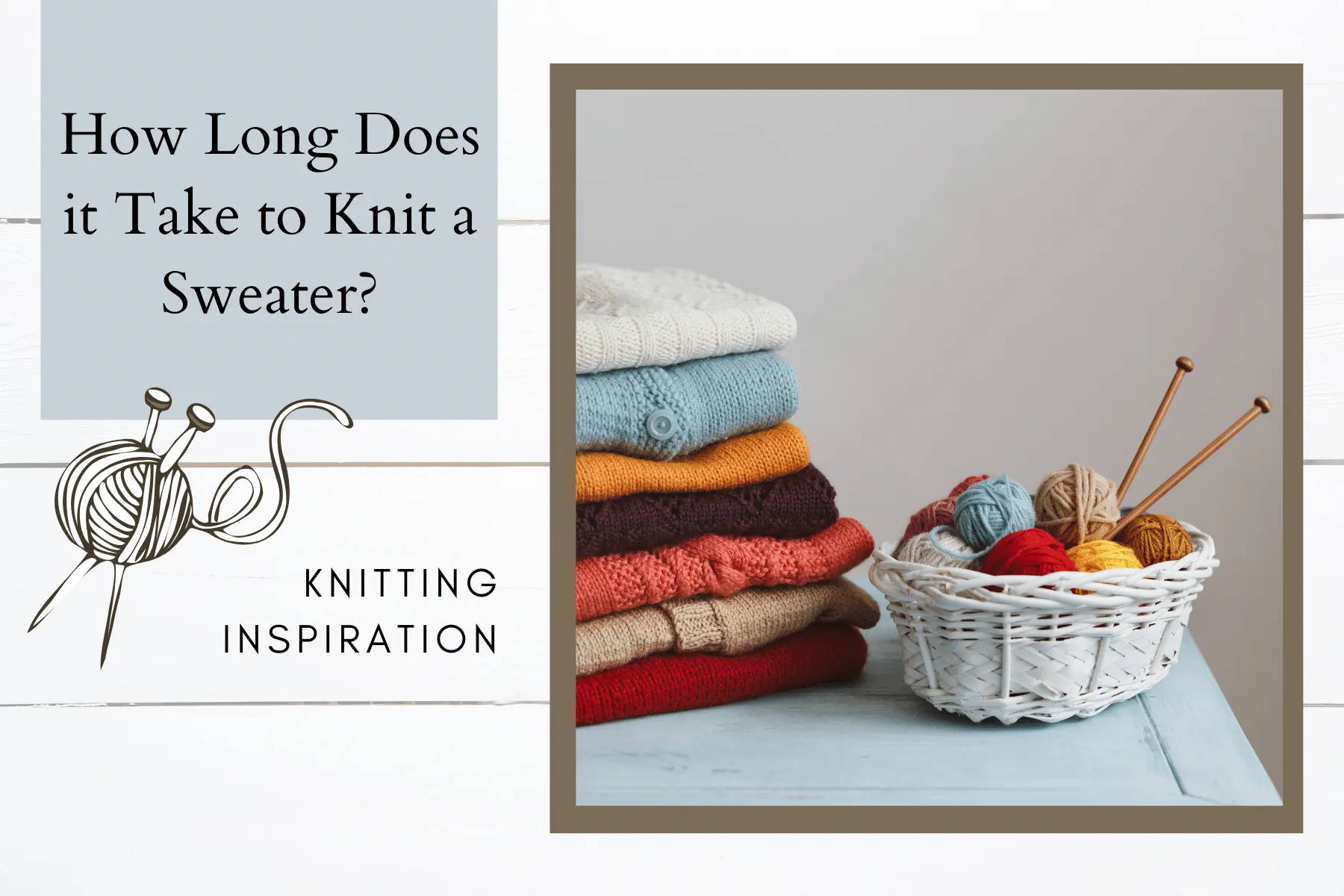HOW LONG DOES IT TAKE TO KNIT A SWEATER?
If you are just starting to take up knitting as a hobby, you might have been sticking to smaller projects, like hats and dishcloths. But if you are ready for a challenge and you’re ready to take on a bigger piece you maybe asking yourself "How long does it take to knit a sweater?".
A sweater is undoubtedly one of the best big projects you can take on at the beginning of your knitting career, and paying attention to details when knitting is very important. Sweaters are popular items to knit for their versatility, practicality and provides a lot of satisfaction! But before you fully invest yourself into knitting a sweater you want to know how long it will take you.


ESTIMATED KNITTING TIME
The average time to knit a sweater depends on the size of the sweater, the type of yarn, and the stitches in the pattern. A simple stockinette stitch sweater in a worsted yarn is a great first time garment project for knitters and will take less time. More complicated sweaters with cables and other stitch patterns can take longer. Lace sweaters can take even longer.
The best way to estimate how long it will take you to knit a sweater is to knit a swatch in the same yarn and stitch pattern as the sweater, and then measure how many stitches and rows you can knit in one hour.
You can also use a knitting machine to speed up the process. With the help of a machine, you can knit a sweater in about two hours. However, this can also depend on how big the sweater is and the type of machine you use.
We will caution that most people pick up the hobby of knitting for the satisfaction in the process of making their items. Although when you are selecting a project it's a good idea to know what kind of commitment you are willing to take on, it's also important that the process of knitting should be enjoyable.
When you are planning your project make sure to plan accordingly with plenty of time to finish, or even rotate other projects in to keep the item from becoming tedious. Many crafters make sure to incorporate "time-out's" in estimating how long it will take to finish a project.
IS IT DIFFICULT TO KNIT A SWEATER?
Difficulty can vary depending on the type of yarn, stitches, and even size, so if you are just starting out look for patterns that indicate a beginner level of difficulty, and either require a lot of the skills you already have or expand on them a bit, you can find them in the stitch guide of a pattern.
Knitting your own sweater is very rewarding. There are a few basic stitching techniques that you will need to know in order to knit a sweater. These include the knit stitch, the purl stitch, and the rib stitch.
One thing that challenges many knitters is ensuring that they achieve gauge through out the entire project. Check our our blog post on ensuring gauge is met.

CAN A BEGINNER KNIT A SWEATER?
The answer is YES! If you're a beginner knitter, you may be wondering if you have enough experience and knitting prowess to knit a sweater. We like to encourage crafters to challenge themselves but in rewarding ways. Find projects that lean into your current skills but maybe have a new stitch or two to challenge you. You may also want to start with a child's or baby sweater to learn on before you start a larger project that can get overwhelming.
Here are some general tips to remember to help you through the process:
- Choose the right size needles
- Cast on loosely
- Use a stitch marker
- Work the ribbing first
- Be patient
- Block your sweater
- Enjoy the process!
HOW LONG DOES IT TAKE TO KNIT AN ADULT CARDIGAN
If you are a fast knitter and spend a lot of time on your project, it can take as little as two weeks to knit an adult cardigan. Again, there are a lot of variables depending on the complexity of the design and the speed of the knitter. For more complex designs or those who like taking their time to knit at a slower pace, it can take weeks or even months. Don't be worried if it takes you longer to knit the sweater, we call it slow fashion for a reason. It is better to take your time and enjoy the process.
As a general guideline, expect to spend at least 40 hours in total knitting an adult cardigan. This time should be broken up into shorter sessions spread out over a few months or worked on in longer stretches as time allows.
IS IT DIFFICULT TO KNIT A SWEATER?

There are many factors that can affect the amount of time it takes to complete a knit sweater, such as the skill level and experience of the crafter, the complexity of the pattern, the type of sweater to knit, the type of yarn used, and the gauge of the knitting.
EXPERIENCE OF THE KNITTER
The experience of the knitter can have a significant impact on the amount of time it takes to knit a sweater. A novice knitter will likely spend more time to complete a project like a knit sweater. If you are new to knitting you may want to factor in some extra time to your project for ripping out stitches or needing assistance with a new technique or pattern. Advanced knitters often have a favorite pattern that they have memorized and may not even need to reference any techniques to achieve their goals.
COMPLEXITIES OF KNITTING PATTERN
A simple stockinette stitch pattern will be much quicker to knit than a more complex cable or lace pattern, often time is saved by not having to move the yarn or needles around, making the construction go by really fast. You'll often find that any mistakes that are made can be quickly repaired in contract to more intricate patterns that would call for multiple types of yarn and more advanced techniques.
There are some time saving repair techniques like working in a lifeline, frequent stitch counting and keeping a repair kit with you. These along with knitting a gauge swatch are wonderful timesavers.
The number of colors used in the pattern can also affect the knitting time. A sweater with a simple two-color pattern will take less time to knit than a sweater with a more complex multi-color pattern because you won’t have to change and join yarns as often.
Type of the Sweater
TYPE OF SWEATER
The different types of sweaters each come with their own unique characteristics. You'll notices that different construction techniques and styles will greatly affect the length of time it takes you to complete your knit sweater. Some stitch designs require more yarn and time to knit, some are small in size like crop sweaters in comparisons to the popular duster style sweater. Naturally, a smaller and more basic sweater can be completed more quickly.
CHOOSING THE TYPE OF YARN
Different types of yarn can have a significant impact on the amount of time it takes to knit a sweater. Using a lighter weight, or thinner yarn yarn will generally require more time than a bulkier weight or thicker yarn. This is because thinner yarns require more stitches and rows to cover the same space. Think of it this way, the same amount of stitches are in a sock and in a sweater, but the sock uses really lightweight yarn.
Additionally, using a different types of yarn can also impact knitting time. Premium Acrylic Yarns like the ones found at Mary Maxim are designed to move on and off your needles smoothly, which you may not find with some natural fibers, making them easier to work with and resulting in shorter knitting times.
If you want to simplify and speed up your sweater knitting project, we recommend the following types of yarn:
- Acrylic yarn
- Alpaca yarn
- Mercerized Cotton yarn
- Linen yarn
- Wool yarn

ACHIEVING GAUGE
Gauge is a term used to describe the number of stitches and rows per inch. It is important when working any fashion item, as it can affect the size and drape of your finished project. If your gauge swatch has less stitches than the recommended gauge in your pattern then, your project will be larger than expected and may not fit properly, the drape could also loose it's structure. If your gauge is too tight or has too many stitches, then the sweater will be too small and often have a stiff uncomfortable drape.
You can usually adjust your gauge by changing the size of your needles or the size of your yarn. For example, if your gauge is too loose, you can try using a smaller needle size, or use a smaller size yarn. If your gauge is too tight, use a larger needle size, or a bulkier yarn, what ultimately matters is that you can achieve the same number of stitches and rows per inch as indicated in the pattern under gage. It is not recommended to make drastic yarn and needle adjustments if you are a beginner, if you do then the fabric may be too stiff or too loose, however slight adjustments will usually be necessary. If you find that you need to make large adjustments to achieve gauge, then change the yarn you are planning on using. After all one can always use more yarn.

Each brand of yarn includes a gauge and is usually measured to 4 inches unless otherwise stated. For instance Mary Maxim Starlette a premium worsted weight yarn worked in stockinette stitch meets a gauge of 18 stitches wide and 24 rows to equal 4 inches with a size 8 (5.00 mm) needles, however if you were to use Starlette and a size 8 needle you may only get 16 stitches per 4 inches. If you knitted a fabric with 100 stitches the finished piece at 18 stitches to 4 inches would be about 22 1/5 inches. If you knitted a fabric with 100 stitches the finished piece at 16 stitch to 4 inches would equal 25 inches. The difference between the two really adds up and is why making a gauge swatch and checking it repeatedly while knitting your sweater will save you a lot of time and make the process more enjoyable.
To better achieve gauge in this instance on example you'd want to side down your needles to a size 7 (4.50 mm) needles and make another swatch until you're closer to the 18 stitches per 4 inches.

